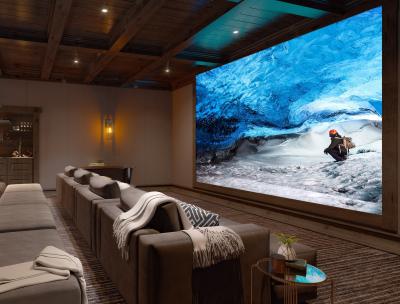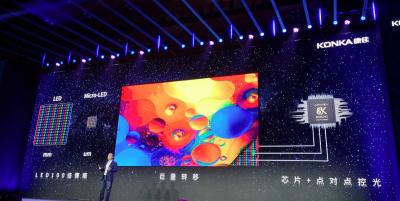Many believe that MicroLED technology will emerge as the next-generation display technology, and one of the first markets for such displays is the TV market. Several companies already offer microLED TVs - which you can already buy today. Assuming you have the money and a large enough room, that is.

As is often the case with new technologies, especially in the display industry, the first few years are marked with extremely high prices and limited selection. MicroLED TVs are no exception - as of 2021, they target the very high-end premium market, with very large TVs and prices starting at around $100,000.
But let's assume you really want to buy a microLED TV and can afford it. What are your options today?
Samsung: The Wall microLED TVs
Samsung launched its "The Wall '' brand of microLED TVs a few years ago, and the company now caters to both the commercial market and the residential market.
The Wall TVs are made from tiled displays (this is true for all microLED TVs on the market today) and so can be customized to any size, or even shape. Samsung, however, offers some pre-fabricated sizes.
Samsung has a 110-inch 4K model, for example, which should start shipping soon. Price is estimated at around $150,000 in Korea (where it will ship first). Samsung says that this TV offers a "breathtaking visual experience", large color gamut, high brightness and accurate color reproduction. The TV is powered by Samsung's all-new Micro AI Processor.
If 110-inch is too large for you, Samsung says it will soon start shipping 99-inch, 88-inch and even 77-inch versions. We do not yet know the prices of these smaller MicroLED TVs, but it will likely be much higher than even premium OLED TVs.
If 110-inch is too small for you, Samsung offers customized The Wall TVs - up to 1,000-inch in size. The company recently installed such a 8K display at its Suwon office. This is a commercial display, under Samsung's The Wall professional brand. We believe the company's consumer-brand TVs (The Wall Luxury) are limited to 'only' 292-inch.
Sony: Canvas LED microLED TVs
Sony was the first company to develop microLED display technology, presenting the first prototype back in 2012, and the first commercial products under the Canvas LED brand (also called CLEDIS sometimes) back in 2016.

Sony recently announced its next-generation Canvas LED displays. The company will offer two types of displays, one focused on high contrast and one on high brightness. Both are powered by a special MicroLED edition of the company's X1 display processor. Sony's displays offer smooth and artifact-free images, 22-bit Super Bit Mapping, HFR (120Hz) and HDR. The new displays will ship by the end of the summer of 2021.
Sony mostly targets commercial installations, but the displays are also offered for residential settings. These are customized displays, made from small microLED tiles. Sony does not publish its prices, but it was reported in 2019 that the 146-inch model costs around $400,000 and the 219-inch display costs around $800,000.
If these are too small for you, no worries - Sony also offers a 440-inch model and even a 790-inch 16K display. In April 2019, Sony produced its largest microLED display - a 19.2 x 5.4 meter display with a resolution of 15360x4320. This display was installed at Shiseido's new research center in Yokohama, Japan.
LG: MAGNIT microLED TVs
LG also developed its own microLED TV technology, which it markets under the MAGNIT brand. These TVs were launched in late 2020.

MAGNIT TVs are made from 160x180 modules, and they offer a brightness of 600 nits (peak 1,200 nits) and LG's AI technology based on its a7 image processor. These are customized TVs, one sample configuration is a 163-inch 4K one.
Unfortunately LG does not disclose the price of its MAGNIT TVs, and we're not even sure if these TVs are actually shipping yet.
Konka: APHAEA microLED TVs
China-based display maker Konka is highly invested in microLED display technologies. The company launched its APHAEA brand of microLED tiled displays back in 2019.

These are customized displays, but Konka offers prefabricated sizes - there's a 118-inch 4K one and a 236-inch 8K one.
Konka says that the prices of its microLED TVs are around 30% cheaper compared to Samsung's The Wall. This is good news for price-conscious consumers, and indeed the 118-inch 4K model costs only $240,000 in China. The 234-inch 8K TV may be cheaper compared to a Samsung display, but you'll need to part with $1.25 million if you want one installed in your home.
Others
Beyond the recognizable brands above, other companies are offering microLED based displays. China's Leyard Opto-Electronics, in collaboration with Epistar, is offering microLED modules. These are geared towards commercial applications, though. Earlier this year, Leyard installed the world's largest microLED display at CHN Energy's new CIC - the display is 216 square meters in size with almost 250 million pixels.

If you want a more residential-friendly option, you may consider C SEED's M1. This 165-inch 4K microLED TV has a unique foldable design. When not in use, the TV folds into the floor. The M1 costs around $400,000 - probably without the installation costs.
When can we expect things to improve?
As you can see, there are several options available today if you want to buy a microLED TV.
But of course, prices are still prohibitively high. It is reasonable to assume that prices will be reduced and more TVs will become available in the near future. However, we do not think that microLED TVs will become price-competitive with premium OLED or QLED TVs in the near future, as the microLED industry still faces major challenges in terms of production processes and costs.

